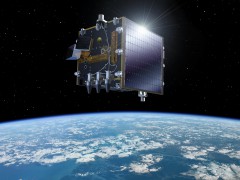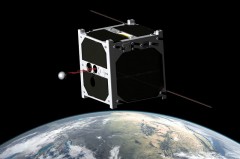
The European Arianespace organization is ready to launch its second Vega lightweight rocket from the Guiana Space Center in Kourou, late Friday evening. The 98-foot-tall, four-stage vehicle will carry three payloads—including Estonia’s first satellite—and will inaugurate a series of five Vega Research and Technology Accompaniment (VERTA) missions to demonstrate its flexibility and ability to transport multiple spacecraft into orbit. After several delays, launch is presently scheduled for 11:06:31 p.m. local Kourou time on Friday (2:06:31 a.m. UTC on Saturday).
Designated “VV-02,” the name pays tribute to the first letter in the French word for “flight” (“vol”), together with the first letter of the Vega itself, and, lastly, the numerical sequence of the mission. In February 2012, the first Vega mission lofted nine discrete payloads—including Italy’s 850-pound Laser Relativity Satellite (LARES)—into orbit, marking a triumphant success after 14 years in development. Although Vega includes co-operation between France, Belgium, The Netherlands, Spain, Switzerland, and Sweden, it is Italy which has driven the program, with a 65-percent contribution. In the wake of its VV-01 mission, Vega joined the medium-lift Soyuz and the heavy-lift Ariane 5 as the third member of Arianespace’s versatile fleet of boosters.
“Vega” is an Italian-language acronym for Vettore Europeo di Generazione Avanzata (Advanced Generation European Carrier Rocket). It has no strap-on rockets, but instead consists of three solid-fueled stages, all built by Avco, the Turin-based aerospace and defense contractor, together with an Attitude Vernier Upper Module (AVUM) fourth stage. The latter employs a bi-propellant liquid-fuel mix of unsymmetrical dimethyl hydrazine and nitrogen tetroxide and is fed by a Russian-built RD-869 engine. Assuming that Friday night’s launch goes as planned, the VV-02 flight will begin with the ignition of the P-80 first stage, which produces a maximum thrust of 683,400 pounds and will burn for the first 109.8 seconds of the flight. The second stage, known as the Zefiro-23, capable of 269,700 pounds of thrust, will then fire for 77.7 seconds, and finally the third stage, the Zefiro-9, with 47,880 pounds of thrust, will ignite for 117 seconds.

After the burnout and separation of the Zefiro-9, the turn will come of the AVUM, which will perform no fewer than four firings to establish its three satellite payloads in their required orbits. During this period, it will deploy Vietnam’s VNREDSat-1 and Estonia’s ESTCube-1 at an altitude of 420 miles and the European Space Agency’s Proba-V at 510 miles. The Estonian satellite is a small CubeSat and is expected to survive for about 12 months, but VNREDSat-1 and Proba-V should endure for up to five years. After the separation of the satellites, the AVUM will perform a final “deorbit” burn to eliminate itself as a space debris threat.
The satisfactory performance of the AVUM is critical to the mission. “The AVUM upper stage will ignite its engine for the first time, operating for about five minutes, followed by a ballistic phase lasting about 42 minutes,” noted Arianespace’s VV-02 launch kit. “The AVUM stage will then reignite its engine for about 90 seconds before releasing the Proba-V satellite, followed by a third to separate [the VESPA dual-satellite adaptor] and then fourth firing to separate VNREDSat-1 and ESTCube-1, lasting about 20 and 60 seconds, respectively.” The Proba-V deployment is scheduled to occur 55 minutes after launch, followed by VNREDSat and ESTCub-1 a little more than an hour later.
From liftoff until final payload separation, the VV-02 mission is scheduled to last two hours and 48 seconds. Originally due to fly in mid-April, it was postponed until 2 May and subsequently moved 24 hours further to the right. According to Arianespace, the slight final delay was made in order “to carry out additional checks on the mobile gantry system used on the Vega launch complex.” All three payloads arrived in French Guiana in March, with Proba-V and VNREDSat-1 touching down at Félix Eboué Airport, near the capital city of Cayenne, aboard a charted Boeing 747 cargo aircraft. By 17 April, the three satellites—including the tiny ESTCube-1—had been encapsulated into the Vega payload stack. At the time of writing this article, processing at the Guiana Space Center continues to proceed smoothly, and Arianespace reported yesterday that final preparations to fuel the AVUM upper stage had been successfully concluded.

The Proba-V is by far the largest payload aboard VV-02. Weighing 308 pounds, it will be placed into a Sun-synchronous orbit of 510 miles, inclined 98.1 degrees to the equator, and will support new technology development for Earth-resources detectors. Specifically, it is equipped with a reduced-mass version of the Vegetation instrument, currently used by the French Spot-4 and Spot-5 satellites, and will provide daily overviews of global vegetation growth patterns. Initiated by the Belgian Science Policy Office, the Proba-V spacecraft was built by ESA and its scientific focuses include land use, vegetation classification, crop monitoring, famine prediction, food security, disaster planning, and biosphere studies. Since the Spot-5 mission is due to end in mid-2014, Proba-V offers vital continuity, ahead of the first launch of the next-generation Sentinel Earth-observation program. In December 2011, Arianespace signed contracts to launch the Sentinel-2B and 3B satellites, which are required to be in orbit in the 2015-16 timeframe.
Sitting “beneath” Proba-V, in the lower position of the VESPA dual-satellite adaptor, will be Vietnam’s VNREDSat-1. This 165-pound payload is part of Vietnam’s effort to develop an orbiting infrastructure to study climate change, predict natural disasters, and optimize the management of natural resources. It was built by Astrium on behalf of the Vietnam Academy of Science and Technology and will be deployed into an orbit of 420 miles. The final payload aboard VV-02 is Estonia’s 2.9-pound ESTCube-1, which has been assembled by students at the National University of Tartu, in conjunction with the Estonian Space Office, the Finnish Meteorological Institute, and the German Space Center (DLR). One of the primary functions of the tiny CubeSat will be the extension of an “ultra-thin and hopefully snap-proof” conducting tether to test electrical solar wind sail technologies.
Assuming a successful second flight for Vega on Friday night, future missions will enable it to show off its capabilities as a light launcher. In addition to its commitment to launch the Sentinel satellites, Arianespace hopes to employ Vega to loft the LISA Pathfinder—a technology demonstrator for the joint NASA/ESA Laser Interferometer Space Antenna mission—into a “halo orbit” at the L1 Earth-Sun Lagrange Point, possibly in 2015.
Want to keep up-to-date with all things space? Be sure to “Like” AmericaSpace on Facebook and follow us on Twitter:@AmericaSpace
Missions » VV02 »


